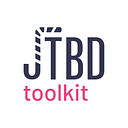Growing Audiences with JTBD: A Conversation with Ruth Hartt
Ruth Hartt is a leading JTBD practitioner and founder of Culture for Hire, a consultancy focused on strategically advising arts organizations. With this, she’s seeking to reverse the downward trajectory of dwindling arts audiences around the world.
It’s no wonder Ruth uses JTBD thinking in her work: she is also Chief of Staff at the Clayton Christensen Institute, a nonprofit think tank dedicated to improving the world through disruptive innovation.
We hosted Ruth as a guest in one of our JTBD Untangled webinar episodes, and she shared some inspiring examples with us. Jim then caught up with her afterward for this brief interview.
JIM: When did you first hear about JTBD and how did you get started using the technique?
RUTH: I was an opera singer and music educator for the first 17 years of my career, so the first time I heard about JTBD was when I joined the Clayton Christensen Institute in an administrative role in 2017. The researchers at the Institute apply business theory to pressing problems in the social sector, and I was inspired to apply JTBD to the problem of audience decline in my former world — classical music.
JIM: Your application of JTBD to the performing arts really demonstrates that it’s a broad field and not just for product innovation. Can you say more about the problem of audience decline in the world of classical music and how JTBD has helped you think through it?
RUTH: Between 1997 and 2017, audiences for classical music performance declined by 50%. If that wasn’t a big enough crisis, the arts world was then hit by COVID-19 shutdowns. Now, if the great acceleration theory proves true, we’re on track to lose another 40% of our audiences.
As I looked at the arts world with the JTBD lens, it became clear to me that the majority of arts organizations had a very product-centric approach that completely ignored the customer. Most of our classical music concert traditions stem from the 19th-century world — meaning, the user experience is designed for a very different world than the one we live in today.
Plus, traditional arts marketing is entirely egocentric, with no mention of the context that today’s consumers find themselves in. We have an amazing product that has so many potential benefits, but instead of showing customers how our product might be relevant in their lives, we tout the virtuosity of the soloist, or the resumé of the conductor, or the biography of the dead white composer.
I was really inspired to bring the concept of customer centricity and JTBD to the arts world. I decided to start creating and sharing examples of what true customer-centric marketing might look like for cultural organizations. Here’s one of my first examples: a contrast between a traditional (boring) orchestra video ad and a truly customer-centric orchestra video ad.
JIM: Those examples really illustrate both the problem and the cure. Thanks for sharing.
I’m curious about your approach and the techniques you use. What specific JTBD methods have you used to start analyzing the space and how did you bring new insights to your customers?
RUTH: The first and most impactful benefit that I believe JTBD brings to the arts world is a seismic shift in perspective. Explaining the difference between a product-centric perspective and the customer-centric or demand-side perspective, especially when it comes to marketing, always brings that “lightbulb moment” for arts leaders.
It really is a completely new way of looking at the world for those in the arts sector. I’ve had some marketers report back to say, “Now I’m seeing egocentric marketing everywhere!”
Many arts organizations are working with very limited resources, and don’t have the capacity to do multiple in-depth customer interviews. While I hope to do more of those, I still think that arts organizations can begin to shift to a more jobs-based approach by looking at global consumer trends and needs in their community.
In my conversations with arts leaders, I encourage them to shift their understanding of their purpose from merely performing classical music — art for art’s sake — by asking “why?” or “to what end?”
When they identify a “deeper why” such as providing opportunities for connection, or offering respite from the noise of the world, they find a powerful compass that guides every aspect of their work from programming to marketing to audience experience.
I also encourage arts leaders to consider the Forces of Progress framework — in particular, to alleviate the anxieties and barriers to prevent nonconsumers from engaging with their art — as well as the JTBD timeline.
So many arts organizations pounce on first-time ticket buyers, barraging them with emails about how to subscribe to the season or become a donor. The JTBD timeline helps them understand that not everyone is ready to take that leap, and that this kind of outreach can be a turnoff.
JIM: What impacts have seen by bringing jobs thinking into arts organizations?
RUTH: I’ve been doing this work for just 18 months, but I’m already seeing a perspective shift happening for many arts leaders — and that’s huge, because the arts sector has clung to its egocentric, product-centric approach for centuries.
Yes, we’re facing an existential crisis. But this is also such an exciting time of opportunity. Because the more we move away from the reverential worship of art and begin to explore how our art can meet the needs of our communities and potential customers, the more relevant and powerful our art becomes. I’m excited to see more arts leaders embrace this new perspective.
With the customer-centric lens shifting their approach to marketing, programming, and audience experience, the arts sector could look very different in five years.
JIM: Thank you, Ruth!
